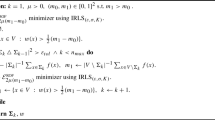Abstract
For general images of smooth objects wholly contained in the field of view, and for illumination symmetric around the viewing direction, it is proven that shape is uniquely determined by shading. Thus, shape from shading is a well-posed problem under these illumination conditions; and regularization is unnecessary for surface reconstruction and should be avoided. Generic properties of surfaces and images are established. Questions of existence are also discussed. Under the conditions above, it is argued that most images are effectively impossible, with no corresponding physically reasonable surface, and that any image can be rendered effectively impossible by a small perturbation of its intensities. This is explicitly illustrated for a synthetic image. The proofs are based on ideas of dynamical systems theory and global analysis.
Similar content being viewed by others
References
Abraham R., and Shaw C. 1983. Dynamics-The Geometry of Behavior, pt. 3: Global Behavior. Aerial Press: Santa Cruz, CA.
Arnold V.I. 1973. Ordinary Differential Equations. MIT Press: Cambridge, MA.
Bruss A.R. 1982. The eikonal equation: some results applicable to computer vision. J. Math. Phys. 23(5): 890–896.
Elliot R.J. 1987. Viscosity Solutions and Optimal Control, Longman Scientific and Technical: New York.
Giblin, P., and Weiss, R. 1987. Reconstruction of surfaces from profiles. Proc. Intern. Conf. Comput. Vision, London, June 1987, pp. 136–144.
Hirsch M., and Smale S. 1974. Differential Equations, Dynamical Systems, and Linear Algebra. Academic Press: NY.
Horn B.K.P. 1975. Obtaining shape from shading information. In The Psychology of Computer Vision. P.H. Winston (ed.), McGraw Hill: New York, pp. 115–155.
Horn B.K.P. 1990. Height and gradient from shading. Intern. J. Comput. Vision 5(1): 37–75.
Horn B.K.P., and Brooks M.J., (eds.) 1989. Shape from Shading. MIT Press: Cambridge, MA.
Horn, B.K.P., Szeliski, R., and Yuille, A. 1990. Impossible shaded images. Submitted to IEEE Trans. Patt. Anal. Mach. Intell.
Oliensis, J. 1989. Existence and uniqueness in shape from shading. University of Massachusetts TR 89-109, October.
Oliensis, J. 1990. Shape from shading as a partially well-constrained problem. Comput. Vision, Graphics, Image Process: Image Understanding, to appear 1991.
Palis J., and de Melo W. 1982. Geometric Theory of Dynamical Systems. Springer-Verlag: New York.
Palis J., and Smale S. 1968. Structural stability theorems. Proc. of Symp. Pure Math. vol. 15, Berkeley, CA, July 1968, pp. 223–231.
Saxberg, B.V.H. 1989a. A modern differential geometric approach to shape from shading. MIT Artificial Intelligence Laboratory, TR-1117.
Saxberg, B.V.H. 1989b. An application of dynamical systems theory to shape from shading. Proc. DARPA Image Understanding Workshop, Palo Alto, CA, May 1989, pp. 1089–1104.
Author information
Authors and Affiliations
Rights and permissions
About this article
Cite this article
Oliensis, J. Uniqueness in shape from shading. Int J Comput Vision 6, 75–104 (1991). https://doi.org/10.1007/BF00128151
Received:
Revised:
Issue Date:
DOI: https://doi.org/10.1007/BF00128151




